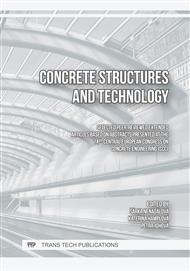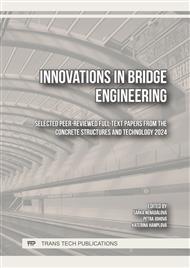p.3
p.15
p.23
p.47
p.57
p.67
p.75
p.83
Probabilistic Model for Thermal Actions on Concrete Bridges Based on Meteorological Measurements - Case Study
Abstract:
Reliability assessments of concrete bridges are currently made using valid codes of practice based on the limit state concept. Verification may be carried out using the partial factor format or structural reliability methods. The reliability assessment should be made taking into account the service life of a structure, the selected reference period, and the changes in the environment of the structure and possibly anticipated changes in use. This contribution focuses on the verification of models for thermal actions for concrete bridges. An example of updating the design value and partial factor for thermal actions using site-specific measurements—shade air temperature measurements and on-bridge measurements—is developed. Two probabilistic models are employed to characterise annual extremes of ambient air temperatures and the effect of choice of the distribution on the partial factor for thermal actions is discussed. It appears that on-bridge measurements may significantly improve the model for both uniform temperature and temperature difference components in comparison to the EN 1991-1-5 model, with reduction of the design value up to 30% in the case study. A useful alternative for practical applications is to update thermal action effects using records from the nearest meteorological station (reduction about 20%). Using either meteorological or on-bridge measurements, the partial factor can be decreased to 1.2 for the uniform temperature component and to 1.3 for the difference temperature component. The choice of probabilistic distribution seems to be of low importance for the bridge under consideration. Further research should be mainly focused on investigating the effects of climate change and analysis of thermal action effects on different types of concrete bridges and bridges from other structural materials.
Info:
Periodical:
Pages:
75-82
Citation:
Online since:
May 2025
Authors:
Price:
Сopyright:
© 2025 Trans Tech Publications Ltd. All Rights Reserved
Share:
Citation:



